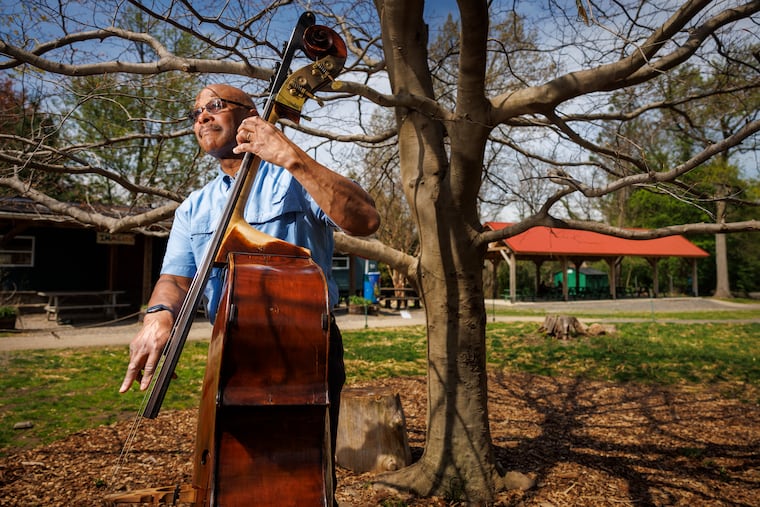24 double bass players will bring new music to Awbury Arboretum for Earth Day
Composer Eve Beglarian found a hunk of birchbark. It inspired the new work “ A Murmur in the Trees .”

Composers have long brought the sounds of birds and trees into the concert hall — Saint-Saëns, Respighi, and Messiaen, among them. This weekend, on Earth Day, Network for New Music brings the music outside and into conversation with nature in two works at the Farm at Awbury Arboretum. Touching Leaves Woman by Mohican and Munsee-Lenape composer Brent Michael Davids is scored for four voices and “bird-roars” — instruments attached to string and spun in the air to produce chirps.
Eve Beglarian’s A Murmur in the Trees summons what is probably a singularly large assembly of double bass players — 24. We spoke with Beglarian about the work, which premiered in 2021 and promises to cast a Zen-like rumble and drone around the Germantown sanctuary. This interview is edited for length and clarity.
Where did the idea of a piece for 24 double basses come from?
Eve Beglarian: It actually got started as part of a collaboration with a visual artist that got waylaid during COVID. I was in Vermont and [double bassist] Robert Black was in Hartford, and there was no way that we could coordinate and do anything. But we had received a grant that sort of was like, “you need to do something.” And Robert had the idea of 24 basses in a grove of trees. The idea of these treelike instruments made out of wood back in a grove of trees just seemed so elegant and intentionally beautiful.
Then, some months later, a friend of mine and I were on a hike and he found a piece of birchbark. And it was just particularly clear that it could be interpreted as a score, that it looked like musical notation if you treated the X axis [horizontal] as duration and the Y axis [vertical] as pitch. And I had been reading a book about trees, and one of the things it said is that trees communicate by means of electrical signals that travel at 1/3 of an inch per minute. So I decided to have this 10-inch piece of birchbark as a 30-minute piece.
Then the decision was what to do about the Y axis, because, of course, you could make it a chromatic scale and then it would be like this crunchy music, you could make it a diatonic scale, you could make it a blues scale — you could do anything you wanted. And so I decided to use the overtone series, simply because that’s the most naturally occurring sort of thing.
In performance do you feel like the trees and the double basses communicate with each other?
It does feel that way when you get out there. Because the music is not loud and busy. It’s much more like part of the atmosphere. And there’s a sense of duetting with the insects and the birds and the wind in the trees much more than laying some trip upon nature, and so there is a definite give and take.
Is there any kind of message to the piece — ecological, environmental?
The original collaboration with the visual artist that started the whole project was a piece about climate change. And I think of myself as really engaged in those subjects but not in a literal-minded way. For me, the way music can contribute to those conversations is to create situations in which you notice and care about nature more, or whatever the subject is. And that may lead to activism.
What does it sound like, 24 double basses all at once?
At the beginning of the piece, the basses are spaced relatively far apart. So as an audience member you have a choice of how you move through the environment, and your experience will vary depending on which basses are near you. And there’s also a sense of distance and depth, because there are basses you can hear playing far away, but they’re much softer than the ones right near us. And then, depending on how large the audience is, the basses contract a little bit to surround the audience a little more closely by the end of the piece. And so then there is really a sense of being enveloped by the sound of the basses.
It strikes me that there are relatively few opportunities to actually walk up to musicians and experience them a few inches away, to have that kind of intimate contact. Was that part of your thinking as well?
I hadn’t really thought about that so clearly until I did it. The first time was like, “Oh, people are really fascinated to go stand right next to the bass player and watch them do what they do,” you know? So yes, that is definitely part of the pleasure.
Brent Michael Davids’ “Touching Leaves Woman” and Eve Beglarian’s “A Murmur in the Trees” are presented by Network for New Music on April 22 at 2 p.m. at the Farm at Awbury Arboretum, 6336 Ardleigh St. in Germantown. In the event of rain, the concert will move to the Presbyterian Church of Chestnut Hill. Tickets are pay-as-you-wish at networkfornewmusic.org.